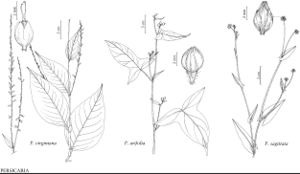Difference between revisions of "Persicaria sagittata"
Beih. Bot. Centralbl. 37(2): 113. 1919.
FNA>Volume Importer |
FNA>Volume Importer |
||
| Line 15: | Line 15: | ||
|name=Polygonum sagittatum var. gracilentum | |name=Polygonum sagittatum var. gracilentum | ||
|authority=Fernald | |authority=Fernald | ||
| − | }}{{Treatment/ID/Synonym | + | }} {{Treatment/ID/Synonym |
|name=Tracaulon sagittatum | |name=Tracaulon sagittatum | ||
|authority=(Linnaeus) Soják | |authority=(Linnaeus) Soják | ||
| − | }}{{Treatment/ID/Synonym | + | }} {{Treatment/ID/Synonym |
|name=Truellum sagittatum | |name=Truellum sagittatum | ||
|authority=unknown | |authority=unknown | ||
| Line 36: | Line 36: | ||
|elevation=0-1000 m | |elevation=0-1000 m | ||
|distribution=Man.;N.B.;Nfld. and Labr. (Nfld.);N.S.;Ont.;P.E.I.;Que.;Ala.;Ark.;Colo.;Conn.;Del.;D.C.;Fla.;Ga.;Ill.;Ind.;Iowa;Kans.;Ky.;La.;Maine;Md.;Mass.;Mich.;Minn.;Miss.;Mo.;Nebr.;N.H.;N.J.;N.Y.;N.C.;N.Dak.;Ohio;Okla.;Pa.;R.I.;S.C.;S.Dak.;Tenn.;Tex.;Vt.;Va.;W.Va.;Wis.;e Asia. | |distribution=Man.;N.B.;Nfld. and Labr. (Nfld.);N.S.;Ont.;P.E.I.;Que.;Ala.;Ark.;Colo.;Conn.;Del.;D.C.;Fla.;Ga.;Ill.;Ind.;Iowa;Kans.;Ky.;La.;Maine;Md.;Mass.;Mich.;Minn.;Miss.;Mo.;Nebr.;N.H.;N.J.;N.Y.;N.C.;N.Dak.;Ohio;Okla.;Pa.;R.I.;S.C.;S.Dak.;Tenn.;Tex.;Vt.;Va.;W.Va.;Wis.;e Asia. | ||
| − | |discussion=<p>Persicaria sagittata is an extremely variable species. Achene and leaf characters have been used by some authors to separate North American and Asian populations, but these characters show weak geographic variation (C. W. Park 1988).</p> | + | |discussion=<p><i>Persicaria sagittata</i> is an extremely variable species. Achene and leaf characters have been used by some authors to separate North American and Asian populations, but these characters show weak geographic variation (C. W. Park 1988).</p> |
|tables= | |tables= | ||
|references= | |references= | ||
| Line 60: | Line 60: | ||
|publication year=1919 | |publication year=1919 | ||
|special status= | |special status= | ||
| − | |source xml=https://jpend@bitbucket.org/aafc-mbb/fna-data-curation.git/src/ | + | |source xml=https://jpend@bitbucket.org/aafc-mbb/fna-data-curation.git/src/8f726806613d60c220dc4493de13607dd3150896/coarse_grained_fna_xml/V5/V5_1181.xml |
|subfamily=Polygonaceae subfam. Polygonoideae | |subfamily=Polygonaceae subfam. Polygonoideae | ||
|genus=Persicaria | |genus=Persicaria | ||
Revision as of 17:36, 18 September 2019
Plants annual, 3–20 dm; roots also often arising from proximal nodes. Stems scandent, ribbed, glabrous; prickles 1–1.5 mm. Leaves: ocrea brownish, cylindric, (3–)5–13 mm, chartaceous, base inflated or not, without prickles, margins oblique, glabrous or ciliate at tip with bristles 0.2–1 mm, surface glabrous; petiole 0.5–4 cm; blade broadly lanceolate to oblong, 2–8.5 × 1–3 cm, base sagittate to cordate, margins entire, ciliate or eciliate, apex obtuse to acute, faces glabrous or densely appressed-pubescent, usually with retrorse prickles along midvein abaxially. Inflorescences capitate or paniclelike, uninterrupted, 5–15 × 4–10 mm; peduncle 10–80 mm, usually glabrous, sometimes with retrorse prickles proximally; ocreolae overlapping, margins eciliate. Pedicels mostly ascending, 1–1.5 mm. Flowers 2–3 per ocreate fascicle; perianth white or greenish white, often tinged pink or red, sometimes entirely pink, glabrous, accrescent, not becoming blue and fleshy in fruit; tepals 5, connate 1/3–1/2 their length, broadly elliptic, 3–5 mm, apex obtuse; stamens 8, filaments distinct, free; anthers pink, ovate; styles 3, connate to middle. Achenes included or styles exserted, light or dark brown to black, 3-gonous, 2.5–4 × 1.8–2.5 mm, dull to shiny, smooth to minutely punctate. 2n = 40.
Phenology: Flowering Jun–Oct.
Habitat: Moist shaded sites, meadows, pastures, fens, swamps, shorelines of ponds and streams
Elevation: 0-1000 m
Distribution

Man., N.B., Nfld. and Labr. (Nfld.), N.S., Ont., P.E.I., Que., Ala., Ark., Colo., Conn., Del., D.C., Fla., Ga., Ill., Ind., Iowa, Kans., Ky., La., Maine, Md., Mass., Mich., Minn., Miss., Mo., Nebr., N.H., N.J., N.Y., N.C., N.Dak., Ohio, Okla., Pa., R.I., S.C., S.Dak., Tenn., Tex., Vt., Va., W.Va., Wis., e Asia.
Discussion
Persicaria sagittata is an extremely variable species. Achene and leaf characters have been used by some authors to separate North American and Asian populations, but these characters show weak geographic variation (C. W. Park 1988).
Selected References
None.
